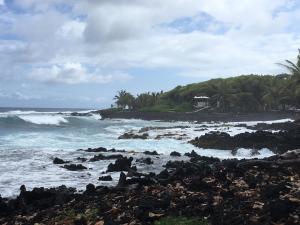Hawaiʻi Island coastal vulnerability, model solution highlighted at COP26
University of Hawaiʻi at Hilo, University of Hawaiʻi at MānoaHawaiʻi Island’s vulnerability to climate change and sea-level rise was highlighted on the global stage at the United Nations Climate Change Conference, COP26, on November 8. A local, community-based solution, co-developed by the University of Hawaiʻi at Hilo and Hawaiʻi County was showcased as a model approach to climate change adaptation challenges.
An inspiring video presented the details of a project co-developed by UH Hilo geography professor Ryan Perroy and Hawaiʻi County Planner Bethany Morrison. Together with UH Hilo student Aloha Kapono, they are generating a comprehensive inventory for Hawaiʻi Island’s 428 kilometers of coastline, collecting high-resolution aerial imagery and ground surveys of its steep sea cliffs, rocky coastal lava fields and white, black and green sand beaches.
Hawaiʻi Island’s coastal vulnerability
With support from the Pacific Islands Climate Adaptation Science Center (PI-CASC) hosted at UH Mānoa, the study builds upon a previous PI-CASC project by UH Hilo Manager Climate Corps master’s student, Rose Hart, who collaborated with Perroy and Morrison to estimate coastal erosion rates for three stretches of Hawaiʻi Island coastline and compared them to projected sea-level rise rates. The ultimate goal of this collaboration is to establish the entire island’s coastal vulnerability to rising sea levels, providing agencies and decision makers with tools to assist in building community resilience to rapidly changing climate conditions.
“These data and products will be a lasting resource for land managers, local government and the scientific community as we grapple with the challenges of building community resilience in a time of rising sea level,” said Perroy.
Mari-Vaughn Johnson, PI-CASC’s federal director, said, “I love the way it showcases how community-based solutions to climate change can work. This project’s deepening of the relationship between UH Hilo and county planners, and contribution to the capacity of the next generation of climate adaptation scientists and managers, is as valuable as the scientific literacy this tool creates.”
Vulnerable U.S. communities
The video illustrating the project was part of a presentation by Doug Beard, Chief of the U.S. Geological Survey’s National Climate Adaptation Science Centers, at a virtual COP26 event sponsored by the Resilience Hub, called “Communities on the front line and local leaders that support them.” The event highlighted vulnerable U.S. communities that are impacted by climate change, featuring a panel of community adaptation and resilience leaders discussing adaptation projects from across the country.
“I was deeply moved by the unique balance achieved in this session of agency leads and high-level expression from experience, alongside wide-ranging voices across communities and across the nation,” said Scott Laursen, co-developer of the Manager Climate Corps. “In each case, on-the-ground voices demonstrated strength through union and empathy, amid vulnerability and great challenges.”

